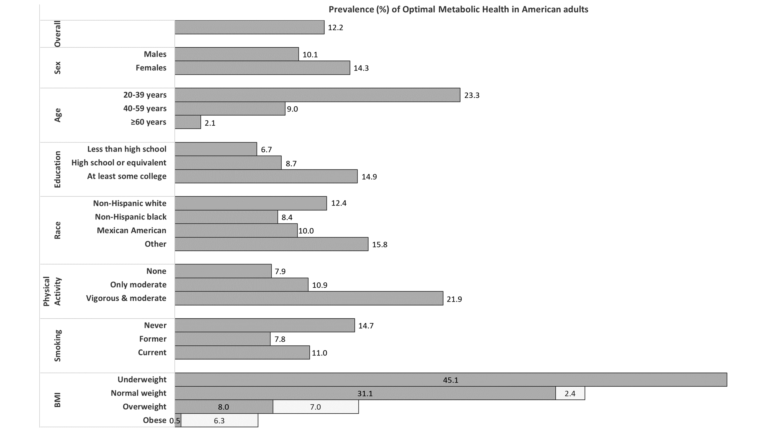This 2019 study used data drawn from the National Health and Nutrition Examination Survey (NHANES) — a large survey of a representative sample of the U.S. population — to assess the share of the population with optimal metabolic health.
Between 2009 and 2016, 8,721 Americans were surveyed. As part of the NHANES protocol, a variety of biometrics were taken, including multiple markers of metabolic health. This study assessed subjects’ metabolic health against six specific criteria:
- Waist circumference <102 cm (men) or <88 cm (women)
- Glucose <100 mg/dL and HbA1c < .7%
- SBP <120 mmHg and DBP <80 mmHg
- Triglycerides <150 mg/dL
- HDLC >40 mg/dL (men) or >50 mg/dL (women)
- Not taking any diabetes, blood pressure, or cholesterol medication
These specific cutoffs were determined based on a survey of current guidelines set by government agencies and scientific societies (1).
Less than half the population had healthy waist circumference (42.6%), blood glucose control (42.8%), or blood pressure (49.6%). Less than three-quarters of the population had healthy triglyceride (74.8%) or HDLC (72.4%) levels. The data indicated 9.0%, 28.6%, and 31.5% of the population were taking diabetes, blood pressure, and cholesterol medication, respectively.
Only 12.2% of Americans met all six criteria and so could be considered to be in optimal metabolic health. When waist circumference was not considered, still only 17.6% of Americans met the other five criteria.
An additional 1.2% of subjects met the five biometric criteria but were on medication to control blood sugar, blood pressure, or blood lipids. These subjects cannot be broadly considered healthy, however, as such medications may obscure underlying disease risk and/or the metabolic syndrome (2).
As shown below, age was a strong predictor of poor metabolic health, with only 2.1% of those over age 60 considered metabolically healthy. Physical activity was only somewhat protective — 21.9% of those participating in regular moderate or vigorous physical activity were metabolically healthy, which implies 78.1% were not.

Figure 1: Prevalence of optimal metabolic health within specific subpopulations. Light grey bars for BMI figures represent prevalence when waist circumference is not considered as an indicator of metabolic health.
The majority of normal weight Americans (66.5%) were not in optimal metabolic health, even when waist circumference was not considered.
The extraordinarily high share of Americans with compromised metabolic health has gained new significance in the context of the increasingly well-established link between poor metabolic health and increased vulnerability to infectious disease. For example, given the established link between diabetes and increased risk of COVID-19 hospitalization and mortality, it is plausible that the 57.2% of Americans with poor blood glucose control are at elevated risk of morbidity and mortality related to infectious disease. Given the high prevalence of metabolic distress, these factors may contribute significantly to the overall health-care burden in the U.S.
